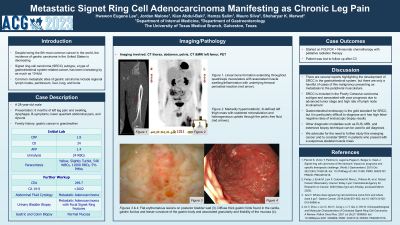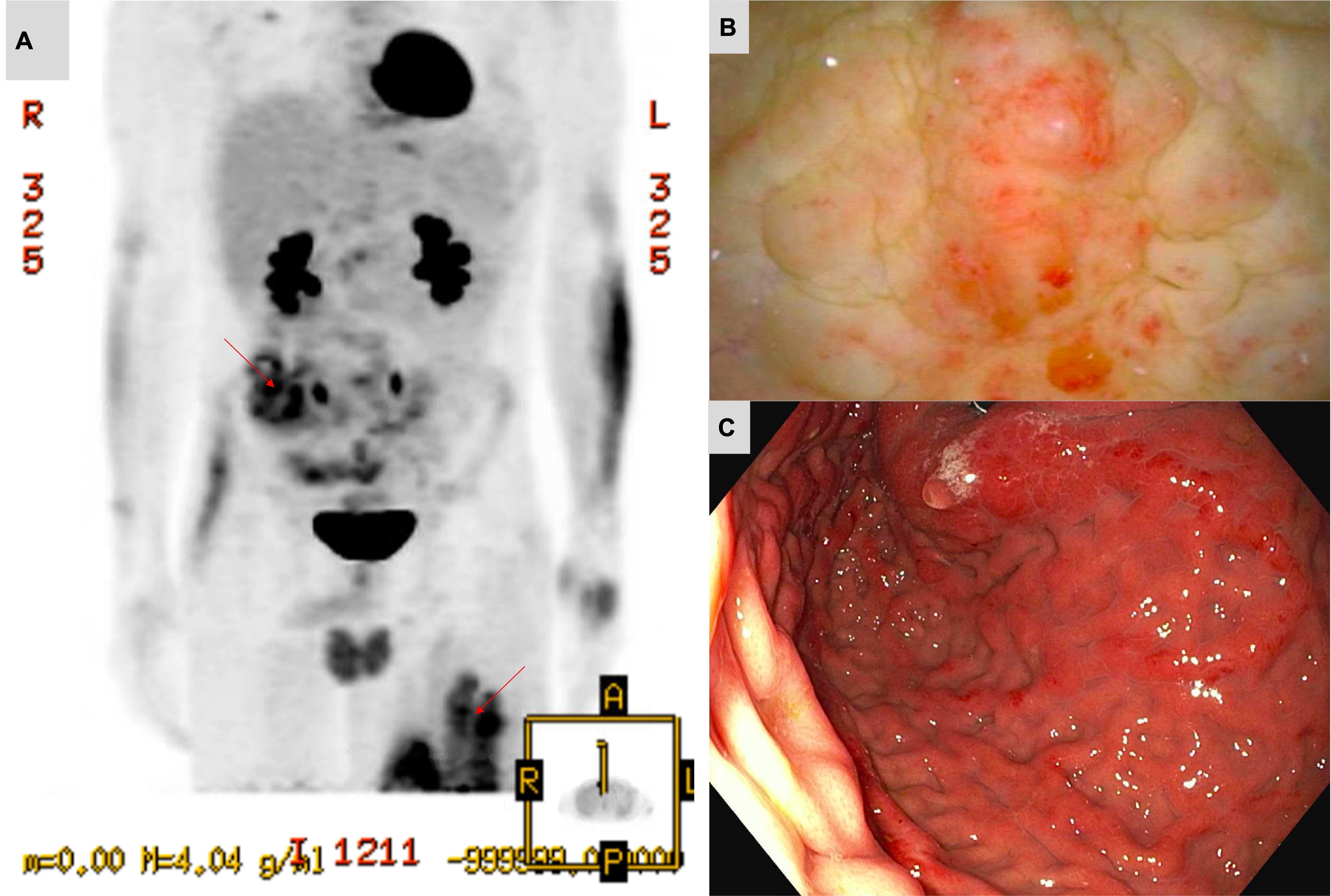Sunday Poster Session
Category: Stomach
P1384 - Metastatic Signet Ring Cell Adenocarcinoma Manifesting as Chronic Leg Pain
Sunday, October 22, 2023
3:30 PM - 7:00 PM PT
Location: Exhibit Hall

Has Audio

Hwe Won E. Lee, DO
University of Texas Medical Branch
Galveston, TX
Presenting Author(s)
Hwewon E. Lee, DO, Jordan Malone, DO, Kian Abdul-Baki, DO, Hamza Salim, DO, Mauro Silva, MD, MPH, Sheharyar Merwat, MBBS
University of Texas Medical Branch, Galveston, TX
Introduction: Although the incidence of gastric carcinoma is decreasing in the United States, it remains the 6th most common cancer in the world. The incidence of signet ring-cell carcinoma (SRCC) in particular, a subtype of gastrointestinal cancer, has been increasing.
Case Description/Methods: A 28-year-old male with a past medical history of bipolar disorder presented with 6 months of pain and swelling of his left leg which had acutely worsened. He also reported intermittent dysphagia, B-symptoms, lower quadrant abdominal pain, and urinary symptoms. Family history was significant for a paternal uncle with colorectal cancer and paternal grandmother with gastric cancer. Vital signs were stable and physical exam were remarkable for swollen, erythematous left leg that was tender to palpation with intact neurologic sensation. Initial labs and infectious workup were non-revealing. Imaging was significant for thickening of the distal esophagus, intestines and bladder wall. Endoscopy revealed gastric folds with associated granularity of the mucosa as well as a focal area of stenosis in the ascending colon. Cystoscopy showed flat, erythematous lesions on the posterior bladder wall. Ultimately, a decision was made to biopsy the leg, which showed metastatic adenocarcinoma with focal signet ring features. Ascitic fluid analysis and bladder biopsy were also consistent with metastatic adenocarcinoma, but gastrointestinal endoscopic biopsies were unremarkable. Oncology suspected a gastrointestinal primary tumor given the clinical picture and recommended palliative chemotherapy and radiotherapy. Before the 4th cycle of chemotherapy, the patient was lost to follow up.
Discussion: This manuscript highlights a rare case of SRCC manifesting as metastasis to skeletal muscle, bladder, and peritoneum. There are only a handful of cases of this malignancy presenting as metastasis to the peripheral musculature. Studies have shown that SRCC typically displays aggressive behavior with a high rate of lymph node involvement resulting in more advanced disease at presentation.
Our case is unique as it demonstrates a rare presentation of SRCC with likely gastrointestinal origin, considering the elevated gastrointestinal tumor markers, imaging findings and the histologic features of metastatic adenocarcinoma with signet ring features. We advocate for the need to further study SRCC and to consider this rare cancer in patients who present with skeletal muscle mass with concerning features for underlying malignancy.

Disclosures:
Hwewon E. Lee, DO, Jordan Malone, DO, Kian Abdul-Baki, DO, Hamza Salim, DO, Mauro Silva, MD, MPH, Sheharyar Merwat, MBBS. P1384 - Metastatic Signet Ring Cell Adenocarcinoma Manifesting as Chronic Leg Pain, ACG 2023 Annual Scientific Meeting Abstracts. Vancouver, BC, Canada: American College of Gastroenterology.
University of Texas Medical Branch, Galveston, TX
Introduction: Although the incidence of gastric carcinoma is decreasing in the United States, it remains the 6th most common cancer in the world. The incidence of signet ring-cell carcinoma (SRCC) in particular, a subtype of gastrointestinal cancer, has been increasing.
Case Description/Methods: A 28-year-old male with a past medical history of bipolar disorder presented with 6 months of pain and swelling of his left leg which had acutely worsened. He also reported intermittent dysphagia, B-symptoms, lower quadrant abdominal pain, and urinary symptoms. Family history was significant for a paternal uncle with colorectal cancer and paternal grandmother with gastric cancer. Vital signs were stable and physical exam were remarkable for swollen, erythematous left leg that was tender to palpation with intact neurologic sensation. Initial labs and infectious workup were non-revealing. Imaging was significant for thickening of the distal esophagus, intestines and bladder wall. Endoscopy revealed gastric folds with associated granularity of the mucosa as well as a focal area of stenosis in the ascending colon. Cystoscopy showed flat, erythematous lesions on the posterior bladder wall. Ultimately, a decision was made to biopsy the leg, which showed metastatic adenocarcinoma with focal signet ring features. Ascitic fluid analysis and bladder biopsy were also consistent with metastatic adenocarcinoma, but gastrointestinal endoscopic biopsies were unremarkable. Oncology suspected a gastrointestinal primary tumor given the clinical picture and recommended palliative chemotherapy and radiotherapy. Before the 4th cycle of chemotherapy, the patient was lost to follow up.
Discussion: This manuscript highlights a rare case of SRCC manifesting as metastasis to skeletal muscle, bladder, and peritoneum. There are only a handful of cases of this malignancy presenting as metastasis to the peripheral musculature. Studies have shown that SRCC typically displays aggressive behavior with a high rate of lymph node involvement resulting in more advanced disease at presentation.
Our case is unique as it demonstrates a rare presentation of SRCC with likely gastrointestinal origin, considering the elevated gastrointestinal tumor markers, imaging findings and the histologic features of metastatic adenocarcinoma with signet ring features. We advocate for the need to further study SRCC and to consider this rare cancer in patients who present with skeletal muscle mass with concerning features for underlying malignancy.

Figure: A: Markedly hypermetabolic, ill-defined left thigh mass with scattered mineralization and heterogeneous uptake through the pelvic free fluid (red arrows).
B: Flat erythematous lesions on posterior bladder wall.
C: Diffuse thick gastric folds found in the cardia, gastric fundus and lesser curvature of the gastric body and associated granularity and friability of the mucosa.
B: Flat erythematous lesions on posterior bladder wall.
C: Diffuse thick gastric folds found in the cardia, gastric fundus and lesser curvature of the gastric body and associated granularity and friability of the mucosa.
Disclosures:
Hwewon Lee indicated no relevant financial relationships.
Jordan Malone indicated no relevant financial relationships.
Kian Abdul-Baki indicated no relevant financial relationships.
Hamza Salim indicated no relevant financial relationships.
Mauro Silva indicated no relevant financial relationships.
Sheharyar Merwat indicated no relevant financial relationships.
Hwewon E. Lee, DO, Jordan Malone, DO, Kian Abdul-Baki, DO, Hamza Salim, DO, Mauro Silva, MD, MPH, Sheharyar Merwat, MBBS. P1384 - Metastatic Signet Ring Cell Adenocarcinoma Manifesting as Chronic Leg Pain, ACG 2023 Annual Scientific Meeting Abstracts. Vancouver, BC, Canada: American College of Gastroenterology.
